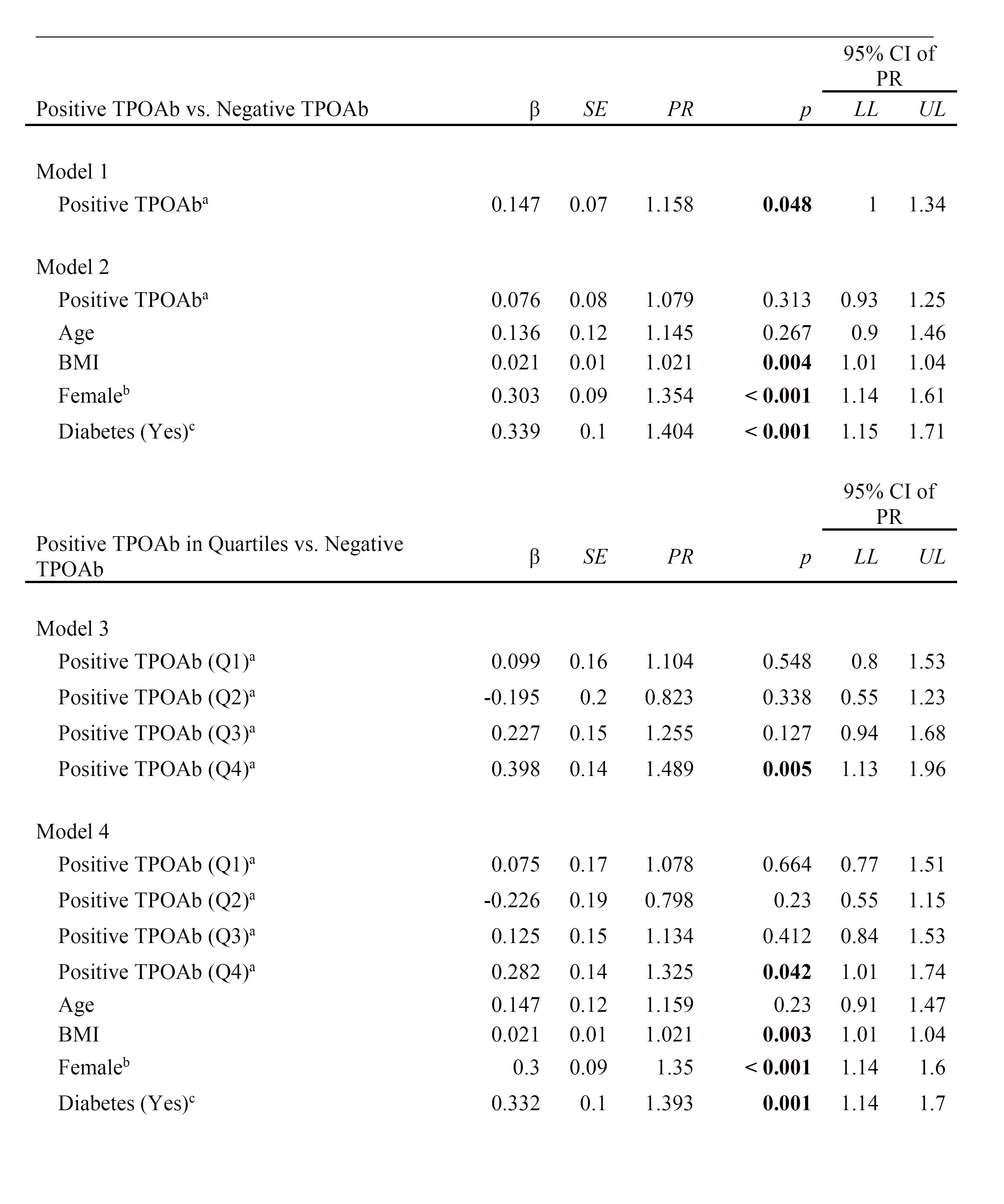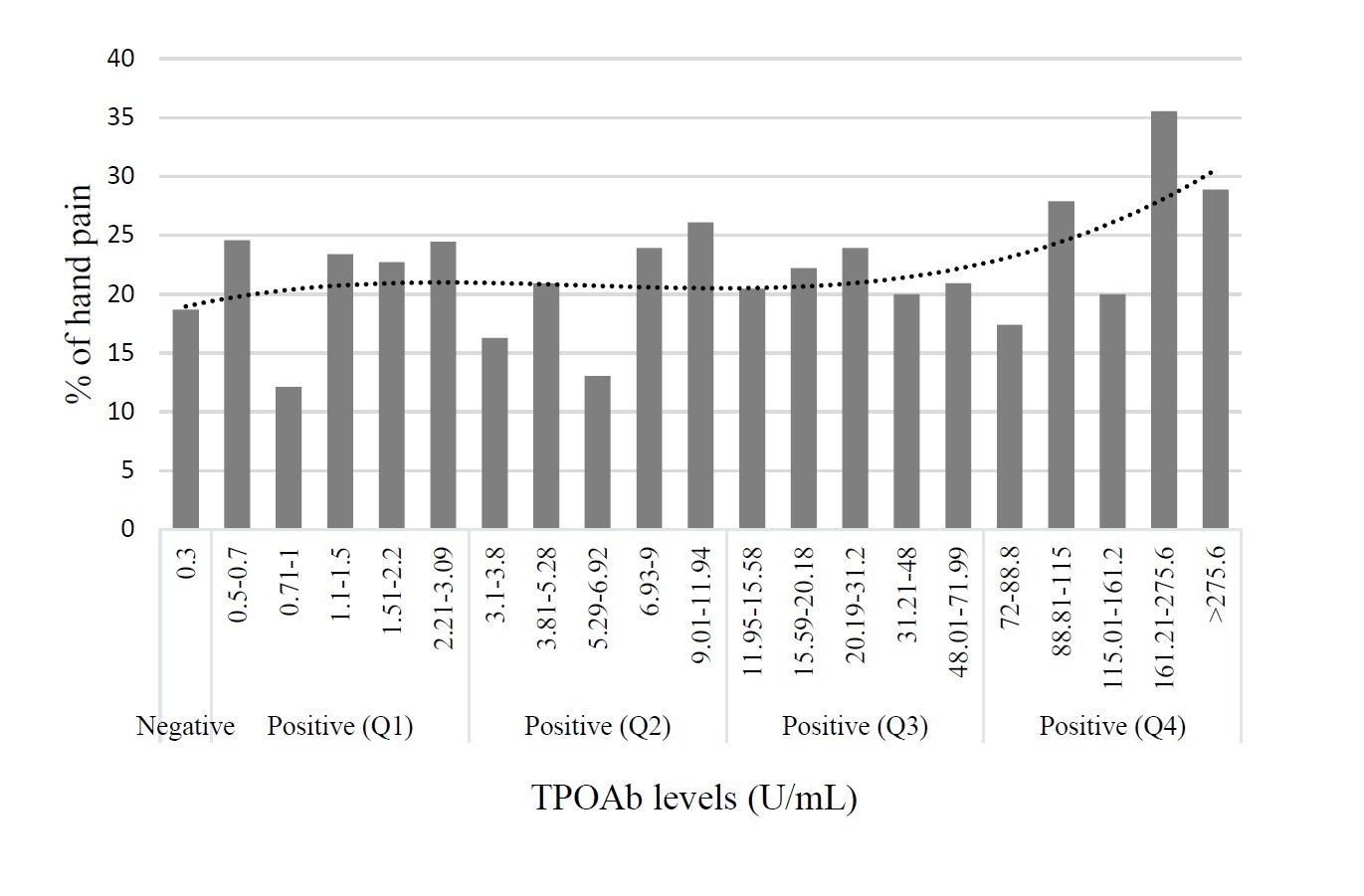Back
Poster Session C
Pain syndromes, fibromyalgia and regional musculoskeletal disorders
Session: (1215–1227) Fibromyalgia and Other Clinical Pain Syndromes Poster
1223: Autoimmune Thyroid Disease Associates with Hand Pain in Older Adults in the Third National Health and Nutrition Examination Survey
Sunday, November 13, 2022
1:00 PM – 3:00 PM Eastern Time
Location: Virtual Poster Hall
- CT
Clement Tagoe, MD, PhD
Albert Einstein College of Medicine
FRESH MEADOWS, NY, United States
Abstract Poster Presenter(s)
Clement Tagoe1 and Wanyi Wang2, 1Albert Einstein College of Medicine, Bronx, NY, 2Elite Research, LLC, Irving, TX
Background/Purpose: Chronic hand pain is a prominent symptom of many forms of arthritis and autoimmune disease. It is often the initial presentation of diseases marked by signs of arthralgia, arthritis, and chronic focal and widespread pain syndromes. Autoimmune thyroid disease (AITD), the commonest autoimmune disease, is increasingly being implicated in the musculoskeletal presentation of chronic pain disorders including peripheral osteoarthritis, spinal degenerative disc disease, and chronic widespread pain (1). The purpose of this study was to examine the relationships between hand pain and AITD through its serologic markers, the anti-thyroid peroxidase antibody (TPOAb) and anti-thyroglobulin antibody (TgAb), in the Third National Health and Nutrition Examination Survey (NHANES III) (2).
Methods: NHANES III interviewed 33,994 participants of an original sample of 39,695. We examined data from both phases 1 (1988–1991) and 2 (1991–1994) on 6596 persons 60 years of age and older with respect to chronic hand pain as defined by the question, "Have you ever had pain in your hands on most days for at least 6 weeks? This also includes aching and stiffness", and its association with TPOAb and TgAb. The sample size for which data existed for the main study variables was 4820, of whom approximately 18.8% of participants reported hand pain. Multiple imputation using fully conditional specification in the chained equation approach was used to replace the missing data (< 2%) on several demographic and clinical variables, such as education, smoking, BMI, diabetes, and thyroid disease. Log-binomial regressions were fit to examine the associations between the anti-thyroid autoantibodies and hand pain.
Results: Positive TPOAb was associated with a higher prevalence of hand pain than negative TPOAb (PR=1.158, p=0.048) in the unadjusted model (Table 1, model 1). The association was lost after controlling for age, body mass index (BMI), gender, and diabetes (p=0.313). When positive TPOAb was considered as a categorical variable with four levels, the highest quartile was associated with hand pain in the unadjusted model 3 (PR=1.489, p=0.005), and adjusted model 4 (PR=1.325, p=0.042) (Table 1). No significant association between TgAb and hand pain was found with or without adjustment for covariates. The percentage with hand pain in each category of TPOAb levels showing the dose relationship is displayed in Fig 1.
Conclusion: The TPOAb of AITD may be a risk factor for the presence of hand pain in persons aged 60 years and over, who make up about 23% of the current US population, especially at higher antibody concentrations ≥72 U/mL. The TgAb was not associated with hand pain in older adults in NHANES III.
 Table 1. a. compared with negative cases; b. compared with male; c. compared with non-diabetes; BMI: Body mass index; TPOAb: thyroid peroxidase antibody; TgAb: thyroglobulin antibody; Q: Quartile; SE: standard error; PR: prevalence ratio; CI: confidence interval; LL: lower limit; UL: upper limit. Significant values in bold text.
Table 1. a. compared with negative cases; b. compared with male; c. compared with non-diabetes; BMI: Body mass index; TPOAb: thyroid peroxidase antibody; TgAb: thyroglobulin antibody; Q: Quartile; SE: standard error; PR: prevalence ratio; CI: confidence interval; LL: lower limit; UL: upper limit. Significant values in bold text.
 Figure 1. Prevalence of hand pain by TPOAb levels
Figure 1. Prevalence of hand pain by TPOAb levels
.jpg)
Disclosures: C. Tagoe, None; W. Wang, None.
Background/Purpose: Chronic hand pain is a prominent symptom of many forms of arthritis and autoimmune disease. It is often the initial presentation of diseases marked by signs of arthralgia, arthritis, and chronic focal and widespread pain syndromes. Autoimmune thyroid disease (AITD), the commonest autoimmune disease, is increasingly being implicated in the musculoskeletal presentation of chronic pain disorders including peripheral osteoarthritis, spinal degenerative disc disease, and chronic widespread pain (1). The purpose of this study was to examine the relationships between hand pain and AITD through its serologic markers, the anti-thyroid peroxidase antibody (TPOAb) and anti-thyroglobulin antibody (TgAb), in the Third National Health and Nutrition Examination Survey (NHANES III) (2).
Methods: NHANES III interviewed 33,994 participants of an original sample of 39,695. We examined data from both phases 1 (1988–1991) and 2 (1991–1994) on 6596 persons 60 years of age and older with respect to chronic hand pain as defined by the question, "Have you ever had pain in your hands on most days for at least 6 weeks? This also includes aching and stiffness", and its association with TPOAb and TgAb. The sample size for which data existed for the main study variables was 4820, of whom approximately 18.8% of participants reported hand pain. Multiple imputation using fully conditional specification in the chained equation approach was used to replace the missing data (< 2%) on several demographic and clinical variables, such as education, smoking, BMI, diabetes, and thyroid disease. Log-binomial regressions were fit to examine the associations between the anti-thyroid autoantibodies and hand pain.
Results: Positive TPOAb was associated with a higher prevalence of hand pain than negative TPOAb (PR=1.158, p=0.048) in the unadjusted model (Table 1, model 1). The association was lost after controlling for age, body mass index (BMI), gender, and diabetes (p=0.313). When positive TPOAb was considered as a categorical variable with four levels, the highest quartile was associated with hand pain in the unadjusted model 3 (PR=1.489, p=0.005), and adjusted model 4 (PR=1.325, p=0.042) (Table 1). No significant association between TgAb and hand pain was found with or without adjustment for covariates. The percentage with hand pain in each category of TPOAb levels showing the dose relationship is displayed in Fig 1.
Conclusion: The TPOAb of AITD may be a risk factor for the presence of hand pain in persons aged 60 years and over, who make up about 23% of the current US population, especially at higher antibody concentrations ≥72 U/mL. The TgAb was not associated with hand pain in older adults in NHANES III.
 Table 1. a. compared with negative cases; b. compared with male; c. compared with non-diabetes; BMI: Body mass index; TPOAb: thyroid peroxidase antibody; TgAb: thyroglobulin antibody; Q: Quartile; SE: standard error; PR: prevalence ratio; CI: confidence interval; LL: lower limit; UL: upper limit. Significant values in bold text.
Table 1. a. compared with negative cases; b. compared with male; c. compared with non-diabetes; BMI: Body mass index; TPOAb: thyroid peroxidase antibody; TgAb: thyroglobulin antibody; Q: Quartile; SE: standard error; PR: prevalence ratio; CI: confidence interval; LL: lower limit; UL: upper limit. Significant values in bold text. Figure 1. Prevalence of hand pain by TPOAb levels
Figure 1. Prevalence of hand pain by TPOAb levels.jpg)
Disclosures: C. Tagoe, None; W. Wang, None.

